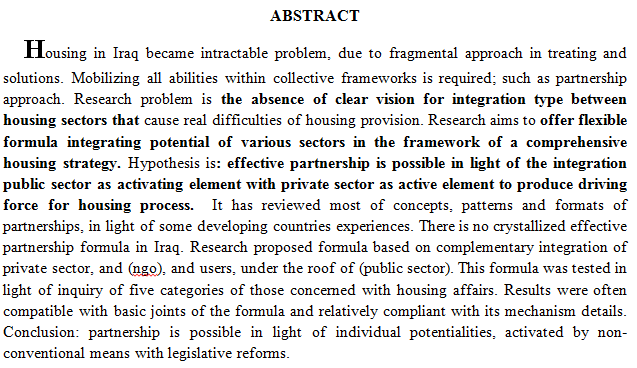
The meteorological data recorded in Al-Hilla station for the period (1984-2014) were used to describe the climatic condition of the Greater Musaiyab Project lies in Babylon Governorate, 90Km southern of Baghdad City, central of Iraq. This study found that the summation of rainfall is (112.323 mm), average of relative humidity (47.44%), temperature (25.55 C◦), sunshine (8.748 h/day) and the total of evaporation is (2268.463 mm). In this research, three classifications were applied to find the type of climate in the study area. The results of the climate classification show that, the climate of study area is characterized by dry and relatively hot in summer, and cold with low rain in winter. Thornthwiat equation was used to determine the
... Show More (7)
(7)
 (4)
(4)
An extensive survey of citrus leaf miner (CLM) , Phyllocnistis citrella Stainton parasites
and predators was conducted during 1998 and 1999 in citrus orchards and nursuries in
Baghdad, Diyala and Wasit .Five eulophid parasites were recorded for the first time on citrus
leaf miner larvae , prepupae and pupae viz. Cirrospilus sp, Pnigalio sp ., Ratzburgiola
incompleta , Tetrasticus sp. and, Neochrysocharis formosa . Parasitism rate was ranged from
15% to 63% Chrysopa carnea , Orius albidipennis , Amblyseius sp . Were observed as
predators on CLM .
The current research deals with studying the petrophysical properties represented by the porosity and its distribution on the level of all units of the top and bottom of the Kirkuk Formation Group. The study area is located in Maysan province in the south-eastern part of Iraq in the Amara field. The Kirkuk Group was deposited in the Tertiary Age. The post-stack method using seismic inversion and creating a relationship between seismic data was accomplished using Hampson-Russel software at well Am-1 and Seismic lines Ama 20 and 30. The research results indicate high porosity values on top of the formation with a decrease in acoustic impedance (Z) and, therefore, a reduction in the density. At the same time, low porosity values were indica
... Show MoreThis study aims to assess the formation evaluation of the Jeribe Formation in Hamrin oilfield. The present study involved four selected wells of (Early- Mid Miocene) Jeribe Formation in Hamrin structure-Allas field; HR-2, HR-8, HR-9, and HR-16 located North of Iraq. The work deals with the available data that includes the most required information to improve such studies. Techlog Software V.2015 was used to carry out a reliable calculation of petrophysical properties utilizing conventional logs to determine the reservoir characteristics (lithology, porosity, and saturation). The computed CPI (software resulted) based on log information divided the Jeribe reservoir into two reservoir units (Jr-1 and Jr
... Show More (1)
(1)
 (1)
(1)
The seismic method depends on the nature of the reflected waves from the interfaces between layers, which in turn depends on the density and velocity of the layer, and this is called acoustic impedance. The seismic sections of the East Abu-Amoud field that is located in Missan Province, south-eastern Iraq, were studied and interpreted for updating the structural picture of the major Mishrif Formation for the reservoir in the Abu-amoud field. The Mishrif Formation is rich in petroleum in this area, with an area covering about 820 km2. The seismic interpretation of this study was carried out utilizing the software of Petrel-2017. The horizon was calibrated and defined on t
... Show More (2)
(2)
Radon concentrations are measured for water samples collected from twenty wells which were drilled in Hashimiya area in addition to twelve samples of surface water using Alpha Gaurd. 140 samples, 7 for each well, were collected represent wet season in continuous pumping and 20 samples, one for each well, were collected represent dry season. Concentration of radon in groundwater is many times of its concentration in surface water. The minimum concentration in groundwater is about (7) Bq/L and (5) Bq/L while the maximum concentration is about (31) Bq/L and (19) Bq/L in wet season and dry season respectively. The range of radon concentrations in river water is between (1.06) Bq/L and (1.21) Bq/L. This study has indicated that there is a flo
... Show MoreProfit is a goal sought by all banks because it brings them income and guarantees them survival and continuity, and on the other hand, facing commitments without financial crisis. Hence the idea of research in his quest to build scientific tools and means that can help bank management in particular, investors, lenders and others to predict financial failure and to detect early financial failures. The research has produced a number of conclusions, the most important of which is that all Islamic banks sample a safe case of financial failure under the Altman model, while according to the Springate model all Islamic banks sample a search for a financial failure except the Islamic Bank of Noor Iraq for Investment and Finance )BINI(. A
... Show MoreArtichoke (Cynara scolymus L.) is a nutritious vegetable that grown all over the world. It is a promising herbal plant, rich in bioactive components. It is considered as medicinal plant due to its nutritional and phytochemical composition, especially high proportion of phenolic compounds. The primary aim of this study was to achieve chemical profile analyses of artichoke for different phytochemcials, especially Scolymoside and Cynaroside. Methanolic crude was extracted from Artichoke leaves by rotary evaporator and separated by column chromatography. The fractions monitored by Thin Layer Chromatography (TLC), and identified in High-Pressure Liquid Chroma
... Show More (1)
(1)
